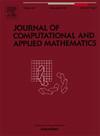Ericksen-Leslie模型的隐式-显式变时间步长BDF2方法
IF 2.6
2区 数学
Q1 MATHEMATICS, APPLIED
Journal of Computational and Applied Mathematics
Pub Date : 2025-02-17
DOI:10.1016/j.cam.2025.116574
引用次数: 0
摘要
这项工作的重点是开发和分析一个完全离散的数值方案的Ericksen-Leslie模型。相邻的时间步长比值γ被定义为执行可变时间步长二阶后向微分公式(VBDF2)。结合标准有限元法建立所需的离散数值格式,采用标量辅助变量法对非线性势进行线性化处理。首先对VBDF2-SAV有限元方案的稳定性和唯一可解性进行了分析。其次,通过严格的误差分析,给出了收敛速度。设计了自适应时间步进策略,在保证精度的同时提高了计算性能。最后,通过数值实验对分析结果进行了验证,并模拟了奇点湮灭现象。本文章由计算机程序翻译,如有差异,请以英文原文为准。
An implicit–explicit BDF2 method with variable time steps for the Ericksen–Leslie model
This work focuses on the development and analysis of a fully discrete numerical scheme for the Ericksen–Leslie model. An adjacent time step ratio is defined to perform the variable time step second-order backward differentiation formulation(VBDF2). The desired discrete numerical scheme is established by combining with the standard finite element method, while the nonlinear potential is linearized using the scalar auxiliary variable(SAV) approach. To begin with, analysis of the stability and unique solvability of the VBDF2-SAV finite element scheme is shown. Secondly, the convergence rates are given by rigorous error analysis. Besides, an adaptive time-stepping strategy is designed to enhance the computational performance while maintaining accuracy. Finally, some numerical experiments are conducted to verify the analytical results and to simulate the annihilation phenomenon of singularities.
求助全文
通过发布文献求助,成功后即可免费获取论文全文。
去求助
来源期刊
CiteScore
5.40
自引率
4.20%
发文量
437
审稿时长
3.0 months
期刊介绍:
The Journal of Computational and Applied Mathematics publishes original papers of high scientific value in all areas of computational and applied mathematics. The main interest of the Journal is in papers that describe and analyze new computational techniques for solving scientific or engineering problems. Also the improved analysis, including the effectiveness and applicability, of existing methods and algorithms is of importance. The computational efficiency (e.g. the convergence, stability, accuracy, ...) should be proved and illustrated by nontrivial numerical examples. Papers describing only variants of existing methods, without adding significant new computational properties are not of interest.
The audience consists of: applied mathematicians, numerical analysts, computational scientists and engineers.

 求助内容:
求助内容: 应助结果提醒方式:
应助结果提醒方式:


